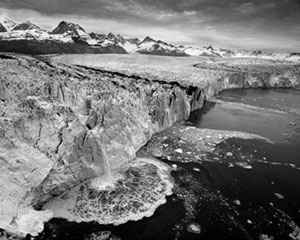Melting glaciers, not ice sheets, primarily responsible for rising sea levels
Melting glaciers, not ice sheets, primarily responsible for rising sea levels
mongabay.com
December 11, 2006
A new study says that melting glaciers are contributing more to the global rise in sea levels than melting ice sheets in Greenland and Antarctica.
Of the estimated 650 billion tons of ice lost to the oceans annually, some 400 billion tons comes from the melting of small glaciers and icecaps, according to Professor Tad Pfeffer of the Institute of Arctic and Alpine Research at the University of Colorado at Boulder. Only 250 billion tons — or less than 40 percent — comes from the melting of the Greenland and Antarctic ice sheets.
“The message from our study is that small glaciers and ice caps are the biggest sources of water in global sea rise, which runs contrary to many news reports focusing on Antarctica and Greenland,” said Pfeffer, who presented the findings today at the annual meeting of American Geophysical Union in San Francisco. “We feel that ignoring the contributions of small glaciers and icecaps is dangerous because it affects the accuracy of predictions of sea rise around the world.”
 Columbia glacier. Image courtesy Tad Pfeffer, CU-Boulder |
Overall global sea levels are rising by about 3 millimeters per year according to other studies, though scientists warn that the rate could increase should atmospheric carbon dioxide concentrations continue to climb.
“We expect that small glaciers will be the biggest contributors to global sea rise for the next 50 to 100 years,” said Mark Meier, an Emeritus Professor at CU-Boulder who then noted that continued temperature rise will likely cause most of the glaciers in the Rocky Mountains and Alps to disappear by the end of the century.
Pfeffer said he hopes that policy makers start to take rising sea level projections seriously.
“I don’t think we can afford to wait until there is two feet of water in our livings rooms to start thinking about a response to changing climate,” he said.
Pfeffer also noted that “increasingly large discharges of fresh water into the oceans from glaciers and ice caps also may be having ecological impacts in coastal regions” including “changes in ocean salinity and temperature, the transport nutrients from land into to marine ecosystems and altered environments for both terrestrial and marine animal species.”
The remains were found at an elevation of 650 feet (200 meters) on Vega Island off the Antarctic Peninsula where harsh winds and freezing temperatures made excavation particularly difficult.
“Weeks of winds exceeding 70 miles an hour hindered the excavation,” explained an NSF statement. “At the end of the work, icy temperatures turned water to slush before plaster could be mixed to encase the fossil for transportation. The ground was so frozen a digging tool snapped in half during the excavation. Finally, a jackhammer had to be carried up to the site in backpacks along with gasoline, plaster, and water.”
“The resulting package of plesiosaur remains encased in a protective plaster jacket was too large to carry, so the Argentine air force brought helicopters to the rescue,” continued the statement. “It took five men to lift the specimen into the chopper, which delivered the cargo to the tent camp on the shores of Herbert Sound. The specimen was later picked up by the Laurence M. Gould, an NSF-chartered research vessel.”
The discovery of “volcanic ash beds layered within the shallow marine sands at the site” lead the researchers to speculate that volcanism may have caused the beast’s demise. Ironically the ask that likely killed the young plesiosaur may have also helped preserved the skeleton said the researchers.
This article is based on a news release from NSF.